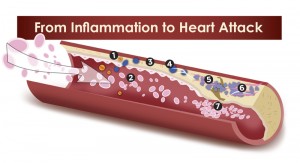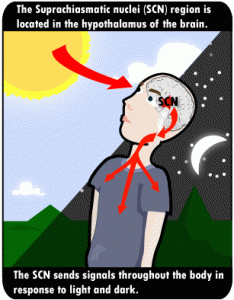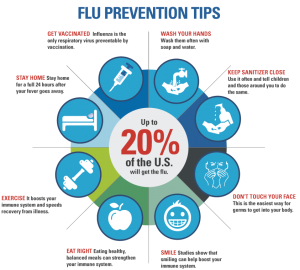This article describes the development from inflammation to heart attacks, strokes and arthritis. Have you ever wondered why people who limp from arthritis in their hip also often get heart attacks? And have you ever wondered why people with high blood pressure get strokes and/or heart attacks? It is not that difficult to understand, although many people do not like to hear the truth. After the holidays with lots of sweet presents and rich food it is a good time to reflect about the internal connections between our organs. Let’s follow what foods can do to our system, then you will understand what to do to get out of the rich food trap, where food is not friendly but damaging to your body.
1. Sugar, omega-6 fatty acids and trans fats enter your system
When you opened the cheap chocolate bars, ate the pastas, the turkey gravy and the ice cream for dessert, your stomach faithfully digested all that food and broke it down into glucose (a simple sugar), omega-6 fatty acids and highly reactive trans fat with free radicals (from deep fried foods, margarine, shortening, pie crusts, cake mixes, frostings and non dairy coffee creamers just to mention a few). Within ½ hour the sugar molecules from the digested meal will enter your blood stream.
2. The metabolism sets in
We know from years and years of research that the glucose in the blood triggers the release of insulin from the pancreas, which facilitates absorption of sugar into your liver and muscles where it is stored as glycogen. This is meant to be a storage form of sugar, just in case you do not eat for a few hours, but need energy to burn for your physical activity. When you have saturated the glycogen storage in liver and muscles, your liver metabolizes sugar into fatty acids and triglycerides. There is the transport LDL cholesterol that is supposed to supply the brain and heart with healthy cholesterol for these organs to replace cell membranes.
Oxidized LDL cholesterol attacks your arteries
Instead, the LDL cholesterol that is supposed to be balanced by the protective HDL cholesterol gets oxidized from the extra sugar and from the free radicals of the TRANS fats that are now being outlawed by the FDA for exactly that reason. So, the oxidized LDL cholesterol turns into the vicious VDLDL particles, which can be measured as a special blood test by your doctor. The overabundance of omega-6 fatty acids start an internal fire by stimulating the arachidonic acid pathway, which causes inflammation in your arteries, your joints and your immune system.
3. The consequences of eating foods which spike your blood sugar levels
The end result is hardening of your arteries and the beginning of arthritis in your joints. Mind you, this does not happen overnight, but when you eat this way decade after decade it takes its toll. Typically in your forties or fifties you will notice some swollen knuckles. Don’t just let this happen. Think that this is a sign that something is festering in you! If you don’t interfere, there could be one wrong move, when you play sports and a meniscal tear in your knee could put an end to the fun. Sure, you will find a reason that the angle of your jump was unfortunate and this was simply enough for your meniscus to tear.
Inflammatory changes in the meniscus
But could it be that there were inflammatory changes in your meniscus long before this incident, the meniscal material softened up, dried up because of a lack of proper nourishing synovial fluid? I found when I was in primary care practice that this was what caused the majority of meniscal tears. A normal meniscus does not tear easily, but decades of malnutrition will lead to these hidden changes, where a meniscus can be softened and is prone to damage without a warning.
Arthritis in your joints is similar to the process of what I described regarding meniscal degeneration. An imbalance of the omega-6/omega-3 ratio where people take in 12 to 16 times as much omega-6 fatty acids from processed food compared to omega-3 fatty acids from fish oil or fish consumed, causes inflammation of the joints via the arachidonic acid metabolism.
Calcifying arteries in patients with vitamin D and K2 deficiencies
What about the arteries? It is no secret that many people in their 60’s have suddenly an episode of chest pain that leads to a referral to a cardiologist who will do a heart catheterization. The physician may have to place a stent or two because of hardening and narrowing of the coronary arteries. In many trials where people with coronary artery disease were followed laboratory tests showed that these individuals had low 25-hydroxy-vitamin D levels in their blood and the calcium that was meant to make their bones strong, ended up in the arteries. Vitamin K2 is often also missing because of malnutrition.
Faulty diet and lack of regular exercise can cause coronary artery hardening
People with high blood pressure often do not have enough nitric oxide production from their arteries, because they do not eat enough vegetables, they are too sessile and they eat too many sweets and starchy foods. As a result, the liver overproduces triglycerides and fat, and oxidized LDL cholesterol damages the lining of the arteries. Just treating high blood pressure with blood pressure lowering medications will not correct the underlying metabolic disbalance. This is why people who had 2 or three stents for coronary artery hardening will come back 5 or 10 years later and need more stents until they die of a full-blown heart attack. You must stop the underlying metabolic derangement, if you want to prevent further deterioration.
4. Inflammation takes its toll
But what do the lining of the arteries, the inflamed joints, a degenerative meniscus and heart attacks and strokes have in common? It is the INFLAMMATION that changes the body chemistry. It gets even more complicated, because the extra calories that we consume get stored as visceral fat. This is done automatically when you eat too much sugar and starchy foods as you may have done over the holidays. Remember, our ancestors were hunters and gatherers, and our genetic make-up is still the same. So, when the glycogen stores are full, any surplus sugar gets metabolized by the liver into triglycerides, fatty acids and LDL cholesterol and gets stored as body fat.
The most active fat is the visceral fat
The most active fat is the visceral fat between our guts and around our body organs. This produces interleukins and other inflammatory cytokines that circulate in the blood causing inflammation in all our arteries.
This is the link between the various manifestations of inflammatory conditions in our bodies. We rarely think that there is a link between all of these various conditions. Physicians concentrate on each disaster as it strikes, but think that it is only a one-point-in-time event. Patients do not see the years of abuse of our bodies that have preceded any of these events.
5. Disaster strikes in different ways
We usually hear about a person who just got a heart attack. Now it is an emergency! Nobody thinks about the years of inappropriate food intake and the lack of exercise that led up to this heart attack event.
The same is true for a sudden stroke. The patient arrives at the hospital in an ambulance and cannot move one arm and one leg. Initially the patient may be unconscious. The emergency personnel is too busy with medical procedures, so they cannot ask the question why it had to come to this. The truth though is that the blood vessel deterioration in the brain vessels that led to the stroke have quietly happened years before the acute event.
Arthritis in older patients
And then there is the aging 75-year-old man with a stiffening hip and arthritis in the hands. The inflammation has been quietly developing in the synovial membranes of the joints for more than a decade. The patient probably swallowed anti-inflammatory medications for years for arthritis symptoms, which as you guessed has not changed the underlying biochemistry. But now it has come to the point where a total hip replacement is necessary, just to be able to continue to walk. I have experienced that scenario in the hospital setting many times. Many patients went through the total hip replacement surgery with no problems.
Some patients develop a heart attack during their surgery for a total hip replacement
But other patients had their total hip replacement done and they developed a heart attack under the general anesthetic. Unbeknown to the orthopedic surgeon the patient also had severe hardening of the arteries. However, this did not show up on the pre-surgical electrocardiogram. A stress test or a Thallium heart scan when the patient still could exercise would have shown this hidden cardiac condition before the surgery, so that a cardiologist could have addressed this condition before the surgery. After that the total hip replacement would most likely have been uneventful.
6. Prevention is the key
The lesson we need to learn from all of this is: prevent these disasters from happening in the first place. Do the following:
1) Good, balanced nutrition
2) Regular exercise.
3) Take vitamins and mineral supplements for bone health.
4) As you age, have your hormones measured and replace what is missing.
5) Avoid toxins. Use detoxification.
6) Avoid junk foods.
I have covered these topics in many blogs before as indicated in the above links.
Conclusion
Health disasters are mostly not accidental. Rather they originate by not paying attention to the silent metabolic changes due to improper nutrition. In addition, a lack of exercise is important as well. You can call this a lack of prevention. It takes some time, often even some suffering to understand the deeper meaning of what I discussed above. In the final analysis prevention is much more powerful on the long-term than curative medicine. I speak from experience having worked in the medical field for more than 30 years. Curative medicine will take care of an emergency. However, the underlying inflammation and metabolic derangement persists, if the physician cannot change this through the steps mentioned above. Treat inflammation and LDL oxidation by modifying your lifestyle. Think prevention!
More information on inflammation medicine: https://www.askdrray.com/chronic-inflammation-causes-cancer-heart-attacks-and-more/















